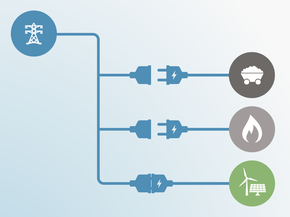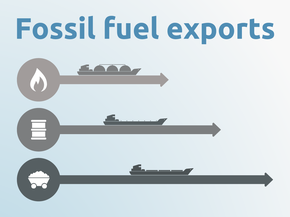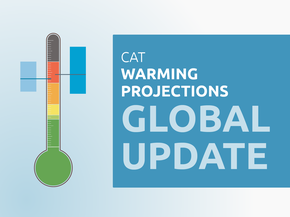Current Policy Projections
Overview
According to our most recent assessment, with currently implemented policies Brazil will reach emissions levels (excluding LULUCF) of 1.156 MtCO2e in 2025 and 1.198 MtCO2e by 2030 (respectively, 28% and 33% above 2005 levels and 97% and 104% above 1990 levels). Brazil will need to implement additional policies to meet its NDC targets.
Recent economic and political turmoil has resulted in an economic recession and non-LULUCF emissions growing at a slower pace than in the last decade and even decreasing slightly in 2015 and 2016. However, under currently implemented policies, emissions in most sectors are expected to rise at least until 2030 and the remarkable progress in forestry emissions mitigation observed over the last decade seems to have stopped with deforestation emissions reverting to an upward trend. Recent developments in energy infrastructure planning and the reversal of LULUCF policies already in place reflect a worsening of national climate policy implementation and ambition.
The election of Bolsonaro is at odds with the urgent need for climate action in Brazil. During campaigns, Bolsonaro flagged opposition to the Paris Agreement, the reduction of greenhouse gas emissions, the maintenance of protected forest areas, ensuring integrity of environmental licensing and to cutting to fossil fuel subsidies (Observatório do Clima, 2018c). With 15 out 27 elected State Governors pledging support to Bolsonaro (Agência Brasil, 2018), it is unlikely to see climate ambition in the key States where climate action is most needed (e.g Amazonas, Minas Gerais, Rio de Janeiro, and São Paulo) going in the opposite direction of future federal policy.
To contribute to a global peak in emissions followed by a steep decrease in the coming decades, as required under the Paris Agreement, Brazil will need to reverse its current trend of weakening climate policy by sustaining and strengthening policy implementation in the forestry sector, reversing present steps to expand fossil fuel energy sources, and accelerating mitigation action in other sectors.
The main policy instruments included in our current policy projections pathway are the energy efficiency national plans and the incentives for the uptake of renewables in the energy sector, including capacity auctions in the power sector and the ethanol and biodiesel mandates in the transport sector (IEA, 2018). In addition to the policies included in the World Energy Outlook, we estimate the impact of The Resolution Nr 5 of June 2018, which includes the annual national emissions intensity targets of the national biofuels policy RenovaBio (Conselho nacional de política energética, 2018).
Brazil has enacted other sectoral plans to reduce emissions in other sectors of the economy, including the Mitigation and Adaptation to Climate Change for a Low-Carbon Emission Agriculture (ABC Plan), the Steel Industry Plan, the Low Carbon Emission Economy in the Manufacturing Industry Plan, The Sectoral Transport and Urban Mobility Plan and the Low-Carbon Emission Mining Plan. Most of those policies and instruments, however, are still not part of national development planning and are therefore not included in our current policy projections emissions pathway.
Land Use and Land Use Change sector
Inventory emissions data available shows that the land use and forestry sector had been by far the largest source of GHG emissions in Brazil since the early 1990s. This picture changed significantly after 2004, when effective anti-deforestation policies, including the National Forest Code, the Action Plan for Deforestation Prevention and Control in the Legal Amazon (PPCDAm) and the Cerrado (PPCerrado), were implemented and resulted in a reduction on LULUCF emissions of about 86% between 2005 and 2012 (Ministry of Science Technology and Innovation of Brazil, 2016a).
While this was a very positive development, the remarkable progress in forestry emissions mitigation seems to have stopped, with deforestation emissions increasing again in recent years (Observatório do Clima, 2018a). Recent data shows that total deforestation increased almost 30% in 2016 compared to 2015 and more than 50% in the Amazon region (IPAM, 2017) (Observatório do Clima, 2017). Experts have estimated that deforestation alone has added around 130 MtCO2 to total net emissions in 2016 (Observatorio do Clima, 2016b), endangering the achievement of the national targets for the Paris Agreement, which include a target of zero illegal deforestation in the Brazilian Amazonia by 2030.
This recent increase in deforestation represents a reversal of the trend over the last decade and local authorities have declared they lack the resources to control illegal deforestation in the entire national territory (Messias, 2017). The enforcing capacity of national authorities has deteriorated due to sharp spending cuts under the recent fiscal austerity principle implemented as a response to the spiralling fiscal deficit. In 2017, the Government cut the Environment Ministry budget by more than 50% (Climate Home, 2017a), with continued cuts in 2018. The National Institute for Space Research (INPE), responsible among others for the satellite monitoring of deforestation in the Amazon, suffered nearly 70% reduction in its budget in the past 7 years (Estado de São Paulo, 2017)
Not only has the enforcing capacity of authorities been reduced, but the Government has also started to reverse LULUCF policies already in place. Last year, President Temer signed legislation, previously approved by Congress, to regularise more illegal land-grabbing practices and sent a bill to Congress that that would remove protection from 349,000 hectares (862,000 acres) of Jamanxim National Forest, in the Amazon state of Pará (Climate Home, 2017b).
This, combined with the economic recession that pushes low income populations to undertake deforestation as an economic activity, could result in growing deforestation emissions in the future, unless continuous efforts to maintain low levels of deforestation are made, and additional policies are implemented to achieve even lower levels (Observatorio do Clima, 2016a).
President-elect Bolsonaro has signalled he wants to go even further than the current government, with plans to eliminate the Ministry of the Environment, which would be merged with the Agriculture Ministry and could be handed over to the ruralists – who traditionally oppose land preservation efforts, and other anti-deforestation policies; open up the Amazon rainforest for mining and agricultural industry; and abolish penalties for the illegal deforestation. During the election campaign Bolsonaro signalled his intention to open up the Amazon rainforest for the mining and agricultural industry, and abolish penalties for illegal deforestation. Deforestation increased by 36% during the election period, due at least in part, national experts say, to illegal loggers responding to his implicit support.(Observatório do Clima, 2018d).
One of the most negative consequences of the lack of progress in deforestation policies is the endangerment of the multilateral Amazon Fund that provides funds to fight deforestation in the Amazon. In June 2017, Norway reduced its contribution to the fund by $60 million and funds could drop even further if current deforestation trends continue (World Resources Institute, 2017). This could result in a downward spiral that could put the NDC target of zero illegal deforestation in the Brazilian Amazon by 2030 out of reach.
In July 2017, the government presented an estimate of official deforestation data in the Amazon showing that deforestation fell by 16% between August 2016 and July 2017 (PRODES, 2017). While these recent changes in the Amazon are encouraging, there is uncertainty about emissions developments in other important regions like Cerrado and Mato Grosso; prolonged drought resulted in an increase in fires in 2017 (Observatorio do clima, 2017); and finally, more recent data (Jan 2018) shows that deforestation for soybean plantations grew 27% from the previous year, mostly in the Mato Grosso region (Observatorio do clima, 2018).
These negative developments in LULUCF policies, which is expected to be worsened by the incoming government, are projected to have negative consequences for deforestation, potentially causing Brazil to miss its 2020 and NDC deforestation targets by a large margin (Rochedo et al., 2018; Soterroni et al., 2018). To illustrate this, we have added alternative projections for LULUCF produced by national experts (Rochedo et al., 2018) to our main graph, showing they stand in stark contrast with the official government projections.
Given the key role of the LULUCF sector in Brazil’s NDC and the huge importance of its forests for environmental services, biodiversity, and carbon sequestration, the Brazilian government needs urgently to strengthen mitigation action in the sector instead of weakening it.
Energy supply sector
Brazil’s energy mix has been characterised by a high share of renewables, especially large hydroelectric generation in the electricity sector. Taking into account that Brazil’s energy market is expanding and will continue to do so at least until 2030 (IEA, 2015), the renewable energy NDC targets of a 45% share in the primary energy mix and a 23% share of renewables (other than hydropower) in the power supply mix by 2030 would, if met, contribute to an improvement in Brazil’s carbon intensity.
However, plans to decarbonise the Brazilian power sector appear to be contradicted by recent policy developments. In fact, the share of fossil fuels in the Brazilian energy matrix is increasing while the share of renewable energy sources in the energy supply has been declining— from around 50% in the 1990s to only 39% in 2014 (Observatorio do Clima, 2016a), and has only started to rise again in the last three years, reaching 47% in 2017 (IEA, 2018). This trend has been driven by an increase in energy demand and challenges the hydroelectric sector has faced in times of scarce water resources (US Energy Information Administration, 2016). Special concern is raised by the current government energy infrastructure planning, which seems to continue favouring fossil fuels, including coal and gas, as opposed to what is required under the Paris Agreement (Climate Action Tracker, 2016).
To meet the increasing energy demand, the government is planning to diversify the energy mix and lower dependency on hydroelectric power by increasing investments in fossil fuels. The Ten-year Plan for Energy Expansion has planned an increase in the share of investments in fossil energy sources to 70.6% of total energy investments in 2024 (Ministério de Minas e Energia, 2015). Between 2013 and 2016, non-renewable sources had an increase of 4.3% in the primary energy production, with same proportion decreasing of renewables, with largest increase coming from oil (Ministerio de Minas e Energia, 2017)
In the second half of 2016 the Senate approved a provision on a bill on electricity sector privatisation that could result in subsidies for the modernisation of the coal fleet and the addition of new coal plants from 2023 onwards (Senado Federal, 2016). The government also sent negative signals to the wind and solar industry by cancelling its only reserve energy auction for wind and solar in December 2016, arguing for an expected power oversupply in the country (Reuters, 2016). Finally, in December 2017 the National Congress approved a further tax exemption to oil and gas exploration, valid until December 2040 which will add up to over a trillion reais (USD 309 billion) lost from the public purse (Câmara dos Deputados, 2018).
However, market developments seem to favour renewable energy over fossil fuels: even though coal generation was allowed to participate in the latest national energy auction, no coal was actually contracted. In fact, 60% out of the 2.1 GW contracted went to wind energy (with average price of 90,45 BRL/MWh, equivalent to 24 USD/MWh), 22% went to hydroelectric and 1.36% to biomass (Reuters, 2018). The only contracted energy from fossil fuels came from a single gas power plant that represented 17.3% of the total capacity contracted, at a price of BRL 179.98/MWh, equivalent to 48 USD/MWh (Reuters, 2018).
While recent developments may ultimately limit the options for long-term deep decarbonisation of the Brazilian economy as a consequence of unnecessarily locking in a high level of carbon-intensive energy infrastructure, market developments bring hope for renewable energy. Under current policy projections, the indicative NDC target of a 45% share of renewables in the total energy mix by 2030 will be achieved. However, unless additional policies are put in place, emissions in the energy sector will continue to rise (IEA, 2015), leaving the huge national potential for renewable power generation untapped.
Agriculture
Agriculture is an important industry in Brazil, due to the immense land resource available. The most significant products are coffee, soybeans, wheat, rice, corn, sugarcane, cocoa, citrus and beef (FAOSTAT, 2017). Agriculture is the second biggest contributor to Brazil’s GHG footprint, being responsible for around half of the country’s emissions once the LULUCF sector is excluded. If the indirect emissions of the agriculture sector (mostly related to deforestation resulting from the expansion of the agricultural frontier) were taken into account, this would be by far the single largest emissions source in Brazil.
Given the importance of agriculture and deforestation in Brazil’s emissions profile, mitigation policies in these sectors play a pivotal role in the achievement of the national emissions reductions targets, which is now in jeopardy after the 2018 elections. The “agriculture caucus” (bancada ruralista) — a party that responds to demands from the agriculture lobby, and which generally opposes land preservation efforts and other anti-deforestation policies — is the second largest coordinated legislative group in the National Congress, with wide representation in State legislatures (Gazeta do Povo, 2018). This political party has been a strong supporter of President-elect Jair Bolsonaro, who signalled his alignment with their agenda during his election campaigns. We will review any changes in policy as they take place after the new Government is sworn in on January 1.
Transport
According to the latest World Energy Outlook (2018), the transport sector accounted for 47% of energy-related CO2 emissions in Brazil in 2017. Emissions have been increasing over recent decades mainly due to increased vehicle ownership. Brazil is currently the world’s second largest producer and consumer of biofuels. In 2017, the country produced an estimated 27.7 billion litres of ethanol and 4.2 billion litres of biodiesel (Berk & Barros, 2017).
In its latest National Communication, Brazil identifies the Sectoral Transport and Urban Mobility Plan for the Mitigation and Adaptation to Climate Change (PSTM) as its key policy to tackle transport sector emissions (Ministry of Science Technology and Innovation of Brazil, 2016b). This Plan aims at contributing to mitigating GHG emissions through initiatives that lead to the expansion of cargo transport infrastructure and using more energy-efficient modes; and in the sector of urban mobility, increasing the use of efficient systems of public passenger transportation.
The Resolution Nr 5 of June 2018 approved the annual national emissions intensity targets under RenovaBio, a new national biofuels policy (Conselho nacional de política energética, 2018). The policy aims to increase the use of all biofuels in Brazil, including ethanol, biodiesel and biomethane, aiming to increase energy security and reduce GHG emissions. Under our current policy projections, the CAT has estimated transport emissions will grow 4-6% from 2017 levels by 2030, which is significantly lower than our previous estimates (23% growth by 2030) that didn’t consider the new RenovaBio targets.
Further analysis
Latest publications
Stay informed
Subscribe to our newsletter







